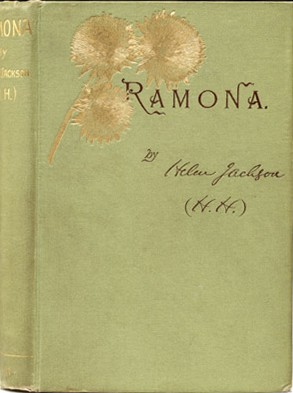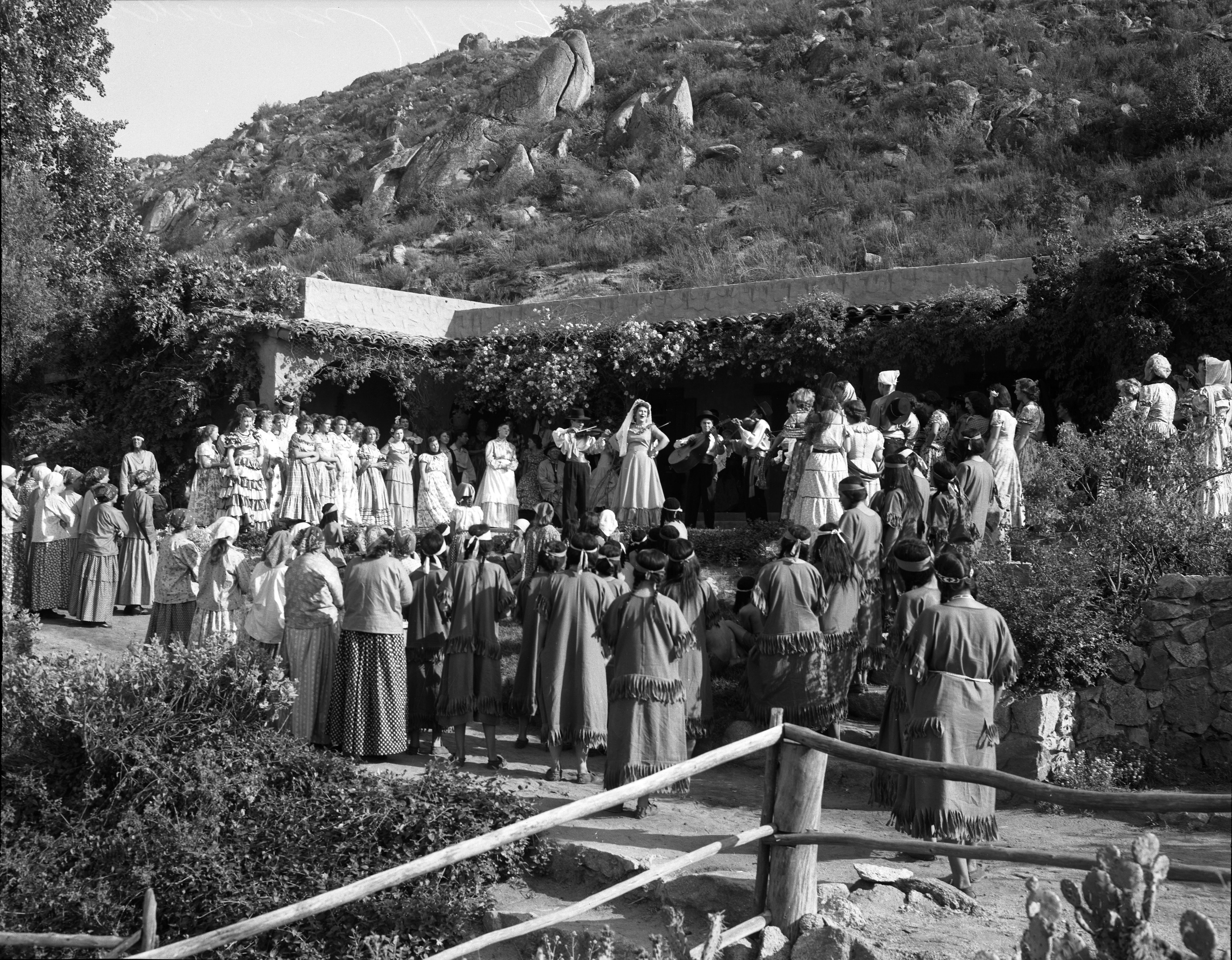 |
| First edition |
Massively popular in its day, Ramona was the work of a well-meaning social activist in
her declining days, and it seems ill-mannered to say anything disagreeable
about her book. But there’s no way around it. Reading this long novel today is
a chore.
Meant as an Uncle Tom’s Cabin to waken sympathy for the ill-treated native
populations of Southern California, the publication of Ramona awoke instead an appetite for romance. Set on a
Spanish land grant ranch in its dying days, it evoked a colonial past that is
more myth than history. And its once-upon-a-time story of a sweet-tempered girl
under the heartless thumb of a wicked foster mother comes straight from fairy
tales.
Plot. Briefly, the
title character is the mixed-blood daughter of a white father and an Indian
mother. Given by the father to his childless former sweetheart unhappily
married to a wealthy man, she is later bequeathed to the woman’s sister, who
unwillingly agrees to raise her.
The Señora Moreno is a widow who rules over what’s left of
a grand old ranch between the San Fernando Valley and the sea, and convenient
to the Camino Real. The missions along that route of the Franciscan Fathers
between San Diego and San Francisco are now crumbling. And the land once deeded
to Spanish lords is falling into the hands of greedy, heartless Americans.
 |
| San Jacinto, (C) Ron Scheer |
They are thrown out of their home by land developers, and
their first child dies for lack of medical attention. They retreat to a hidden
valley on the flanks of San Jacinto, a mountain now overlooking Palm Springs.
Deranged with hopeless melancholy, Alessandro is shot and killed by a white man
for the misappropriation of a horse.
Ramona is eventually found near death by Felipe, the son
of the now-deceased Señora Moreno. Having rescued her and the couple’s second
child, he offers marriage. Though Alessandro remains her true love even in
death, Ramona accepts, and they leave California to live in Mexico.
 |
| Cahuilla woman, Edward S. Curtis |
Simple and trusting folk, the Indians are powerless
against the unscrupulous land grabbers who swarm into California after it
becomes a part of the U.S. With the help of Congress and the courts, their
rights to ancestral lands are being swiftly abolished. And as wards of the
state, they find their lives being managed by Indian agents with little real
concern for their welfare.
Confused like children in a suddenly alien and hostile
world, they are ennobled by Jackson who makes them patiently accepting of their
tragic fate. As they grieve their losses, there is anger among them but little
resistance. They flee before the hated Americans like Adam and Eve from the
Garden, starving and without shelter.
The Señora’s paternal interest in the Indians, however,
does not prevent her from regarding them as an inferior race. They are meant to
be no more than servants. Her barely concealed contempt for Ramona results
directly from the girl’s mixed parentage, which is so shameful that it has been
kept secret from even Ramona herself.
 |
| Fruit brand label, 1900 |
Introduced late into the novel is a family of migrants
from Tennessee, the Hylers. Though Aunt Ri, the matriarch of the family is
unschooled and unpolished, she has a heart of pure gold. Her experience of
Indians in California totally erases any prejudices she has against them.
Women. Ramona, as
the novel’s heroine, offers a portrayal of womanhood that would surely make
feminists grind their teeth. Forever uncomplaining, she permits herself to be
bossed around by her foster mother and often treated like a prisoner. Unloved,
she blames herself and makes every attempt to appease her when the woman is
displeased.
As a wife to Alessandro, she is tirelessly patient and
trusting, her disposition ever sunny and hopeful, even as he slides into a sea
of woe. She prays to the Virgin for protection and guidance pretty much without
ceasing. By her example, she teaches the girls among her readers that a woman’s
role is to be unspoiled, obedient, and long suffering.
 |
| Helen Hunt Jackson |
Romance. The love
affair between Ramona and Alessandro is sweetly told. It is he who is first
smitten, and he makes himself domestically useful by tending to Felipe who has
been stricken by illness and takes comfort from Alessandro’s singing and violin
playing.
Handsome and manly, he, awakens a womanly desire in Ramona
that grows into powerful feelings of first love. The two lovers are innocents
and have the hope and faith of the young. Though their lives together are
fraught with adversity, Ramona is indomitable. Going for melodrama in a big
way, Jackson has Alessandro driven out of his mind by their misfortunes and his
death is cruelly unjust. But Ramona’s pure and unsullied love for him continues
unaltered even by his death.
Wrapping up.
Helen Hunt Jackson (1830-1885) had taken an interest in Native Americans
late in her life. Exposing a legacy of duplicity on the part of the federal
government, she became an outspoken advocate for the tribes in Southern
California.
 |
| Ramona Pageant, Hemet, California, 1950 |
Ramona remains
a popular classic of the period and continues to have a loyal following.
It helped to create California as an early tourist destination that has its
effect in the American imagination still today. Annual performances dramatizing
the story have been held at an outdoor amphitheater in Hemet, California, since 1923.
The novel was made into a short film by D. W. Griffith in
1910 starring Mary Pickford. [See below]. A feature length adaptation appeared in 1928 with
Dolores del Rio as Ramona and Warner Baxter as Alessandro. Loretta Young
starred in a 1936 version with Don Ameche as Alessandro.
Ramona surely influenced the fiction of later writers as we find its themes embedded in novels like Maria Amparo Ruiz de Burton’s The Squatter and the Don (1885), Gertrude Atherton’s Los Cerritos (1890), Mary Austin’s Isidro (1905), and Charles Duff Stuart’s Casa Grande (1906).
Ramona is currently available online at google books and Internet Archive and for kindle and the nook.
Further reading:
Image credits:
San Jacinto, Ron Scheer
All others, Wikimedia Commons
Coming up: Old West glossary of strong drink
A social activitist that hoped to gain the sympathy for one group and created an interest in romance... Sounds also a bit like "The Jungle," where the author did something other than what had been intended. Although I haven't read this (and probably won't), I thought "Uncle Tom's Cabin" and "The Jungle" were longer than neceassary, so maybe there is something about those with such ambitions. Was this book first published as a serial in a newspaper?
ReplyDeleteNo, I don't think it was serialized.
DeleteYes, it was originally serialized in a magazine. Doris ( I work as a chautauquan as Helen).
DeleteDefinitely a problem when a whole race of people are depicted as well meaning children.
ReplyDeleteI'm sure she meant to make them seem sympathetic by idealizing them in this way and making innocent victims of them.
DeleteI have what may be a first edition of Ramona, though I'll confess I didn't know much about it -- I picked it up because it's an attractive-looking old book. I'll have to give it a closer look.
ReplyDeleteIf it's a first edition, it may be worth something.
DeleteWritten in the style of the 1870's it is not an easy read. I agree with your review for the most part. I think because she had not been successful with "Century of Dishonor" she was hoping to soften the story with the hope that more people would read it and take action. "Century" reads like a legal document and is pretty dry, but full of some outspoken comments. Because a very popular author of the time was taking an unpopular stand, it was not widely read. (Although she did send a copy to all the members of Congress) Doris
ReplyDeleteThat is my understanding as well. Thanks for clarifying above regarding serialization.
DeleteIt's fascinating how women writers of the late 19th century and early 20th century weaved so many elements into their stories and, I think, nowhere is this more evident than in early western fiction. Reading this novel today may be a "chore" but I'd love to read it all the same because of its wholesomeness. Such books appeal to me though I'm not sure I'd like to read RAMONA as an ebook. Thank you for the excellent review, Ron.
ReplyDeleteThanks, Prashant. RAMONA is, in fact, a curiosity looked at from several angles. It might have seemed less of a chore if I knew I wasn't writing it up and should therefore read every word and take notes as I went.
DeleteAlways wanted to see the Ramona pageant, but was never there when it was being held. Ramona is a nice little town, though.
ReplyDeleteAssuming the place has survived the recent wildfires, I'd like to get over there sometime myself for a show.
Delete